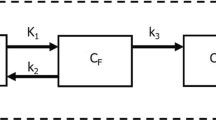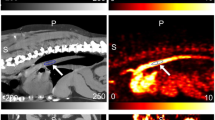Abstract
Purpose
The 2-(2-nitroimidazol-1-yl)-N-(3,3,3-trifluoropropyl)acetamide (EF3) is a 2-nitroimidazole derivative which undergoes bioreductive activation under hypoxic conditions. Using the PET tracer [18F]EF3 in mice, tumour-to-muscle ratios ranging from 1.3 to 3.5 were observed. This study investigated the impact of various interventions aimed at increasing [18F]EF3 elimination, thus potentially increasing the tumour-to-noise ratio in mice, by increasing the renal filtration rate (spironolactone, furosemide), decreasing tubular re-absorption (metronidazole, ornidazole, amino acid solution) or stimulating gastro-intestinal elimination (phenobarbital).
Methods
C3H mice were injected i.v. with an average of 12.95 MBq of [18F]EF3. Drugs were injected i.v. 15 min before the tracer or daily 4 days prior to the experiment (phenobarbital). Anaesthetised mice were imaged from 30 to 300 min with a dedicated animal PET (Mosaic, Philips). Regions of interest were delineated around the tumour, bladder, heart, liver and leg muscle. Radioactivity was expressed as a percentage of injected activity per gram of tissue.
Results
Ornidazole decreased the urinary excretion and increased the liver uptake of [18F]EF3, but without causing any changes in the other organs. Phenobarbital significantly increased the liver concentration and decreased radioactivity in blood and muscle without affecting the tracer uptake in tumour. Consequently, a small but non-significant increase in tumour-to-noise ratio was observed. Although some effects were observed with other drugs, they did not modify the tumour-to-noise ratio.
Conclusion
Only phenobarbital induced a trend toward an increased tumour-to-noise ratio that could possibly be tested in the clinical situation.



Similar content being viewed by others
References
Bush RS, Jenkin RD, Allt WE, Beale FA, Bean H, Dembo AJ, et al. Definitive evidence for hypoxic cells influencing cure in cancer therapy. Br J Cancer Suppl 1978;37:302–6.
Hockel M, Schlenger K, Aral B, Mitze M, Schaffer U, Vaupel P. Association between tumor hypoxia and malignant progression in advanced cancer of the uterine cervix. Cancer Res 1996;56:4509–15.
Fyles AW, Milosevic M, Wong R, Kavanagh MC, Pintilie M, Sun A, et al. Oxygenation predicts radiation response and survival in patients with cervix cancer. Radiother Oncol 1998;48:149–56.
Hockel M, Knoop C, Schlenger K, Vorndran B, Baussmann E, Mitze M, et al. Intratumoral pO2 predicts survival in advanced cancer of the uterine cervix. Radiother Oncol 1993;26:45–50.
Nordsmark M, Overgaard M, Overgaard J. Pretreatment oxygenation predicts radiation response in advanced squamous cell carcinoma of the head and neck. Radiother Oncol 1996;41:31–9.
Hodgkiss RJ. Use of 2-nitroimidazoles as bioreductive markers for tumour hypoxia. Anticancer Drug Des 1998;13:687–702.
Sorensen M, Horsman MR, Cumming P, Munk OL, Keiding S. Effect of intratumoral heterogeneity in oxygenation status on FMISO PET, autoradiography, and electrode pO2 measurements in murine tumors. Int J Radiat Oncol Biol Phys 2005;62:854–61.
Josse O, Labar D, Georges B, Gregoire V, Marchand-Brynaert J. Synthesis of [18F]-labeled EF3 [2-(2-nitroimidazol-1-yl)-N-(3,3,3-trifluoropropyl)-acetamide], a marker for PET detection of hypoxia. Bioorg Med Chem 2001;9:665–75.
Yang DJ, Wallace S, Cherif A, Li C, Gretzer MB, Kim EE, et al. Development of F-18-labeled fluoroerythronitroimidazole as a PET agent for imaging tumor hypoxia. Radiology 1995;194:795–800.
Evans SM, Kachur AV, Shiue CY, Hustinx R, Jenkins WT, Shive GG, et al. Noninvasive detection of tumor hypoxia using the 2-nitroimidazole [18F]EF1. J Nucl Med 2000;41:327–36.
Ziemer LS, Evans SM, Kachur AV, Shuman AL, Cardi CA, Jenkins WT, et al. Noninvasive imaging of tumor hypoxia in rats using the 2-nitroimidazole [18F]EF5. Eur J Nucl Med Mol Imaging 2003;30:259–66.
Mahy P, De Bast M, Leveque PH, Gillart J, Labar D, Marchand J, et al. Preclinical validation of the hypoxia tracer 2-(2-nitroimidazol-1-yl)-N-(3,3,3-[18F]trifluoropropyl)acetamide, [18F]EF3. Eur J Nucl Med Mol Imaging 2004;31:1263–72.
Mahy P, De Bast M, Gillart J, Labar D, Gregoire V. Detection of tumour hypoxia: comparison between EF5 adducts and [18F]EF3 uptake on an individual mouse tumour basis. Eur J Nucl Med Mol Imaging 2006;33:553–6.
Akel G, Canal P, Soula G. Renal elimination of the hypoxic cell radiosensitizer misonidazole in Wistar rats: influence of some drugs on its excretion. Eur J Drug Metab Pharmacokinet 1985;10:181–7.
de Jong M, Barone R, Krenning E, Bernard B, Melis M, Visser T, et al. Megalin is essential for renal proximal tubule reabsorption of 111In-DTPA-octreotide. J Nucl Med 2005;46:1696–700.
Barone R, Pauwels S, De Camps J, Krenning EP, Kvols LK, Smith MC, et al. Metabolic effects of amino acid solutions infused for renal protection during therapy with radiolabelled somatostatin analogues. Nephrol Dial Transplant 2004;19:2275–81.
Schuetz EG. Induction of cytochromes P450. Curr Drug Metab 2001;2:139–47.
Milas L, Hunter N, Mason K, Withers HR. Immunological resistance to pulmonary metastases in C3Hf-Bu mice bearing syngeneic fibrosarcoma of different sizes. Cancer Res 1974;34:61–71.
Surti S, Karp JS, Perkins AE, Cardi CA, Daube-Witherspoon ME, Kuhn A, et al. Imaging performance of A-PET: a small animal PET camera. IEEE Transactions on Medical Imaging 2005;24:844–52.
Workman P, Brown JM. Structure-pharmacokinetic relationships for misonidazole analogues in mice. Cancer Chemother Pharmacol 1981;6:39–49.
Yang XP, Liu YH, Rhaleb NE, Kurihara N, Kim HE, Carretero OA. Echocardiographic assessment of cardiac function in conscious and anesthetized mice. Am J Physiol 1999;277:H1967–74.
Stypinski D, Wiebe LI, Tam YK, Mercer JR, McEwan AJ. Effects of methoxyflurane anesthesia on the pharmacokinetics of 125I-IAZA in Sprague-Dawley rats. Nucl Med Biol 1999;26:959–65.
Acknowledgements
Nicolas Christian is a research fellow of the Fonds de la Recherche Scientifique of Belgium (F.R.I.A., Fonds pour la formation à la Recherche dans l’Industrie et l’Agriculture). The project was supported by a grant from the “Fonds Joseph Maisin”, Brussels, Belgium, by the European Commission’s Sixth Framework Programme funding (Contract no. LSHC-CT-2004-505785), and by a program project from the “Institut National du Cancer” of France (Project INCa N° RS 020).
Author information
Authors and Affiliations
Corresponding author
Rights and permissions
About this article
Cite this article
Christian, N., Bol, A., De Bast, M. et al. Determination of tumour hypoxia with the PET tracer [18F]EF3: improvement of the tumour-to-background ratio in a mouse tumour model. Eur J Nucl Med Mol Imaging 34, 1348–1354 (2007). https://doi.org/10.1007/s00259-007-0376-7
Received:
Accepted:
Published:
Issue Date:
DOI: https://doi.org/10.1007/s00259-007-0376-7




